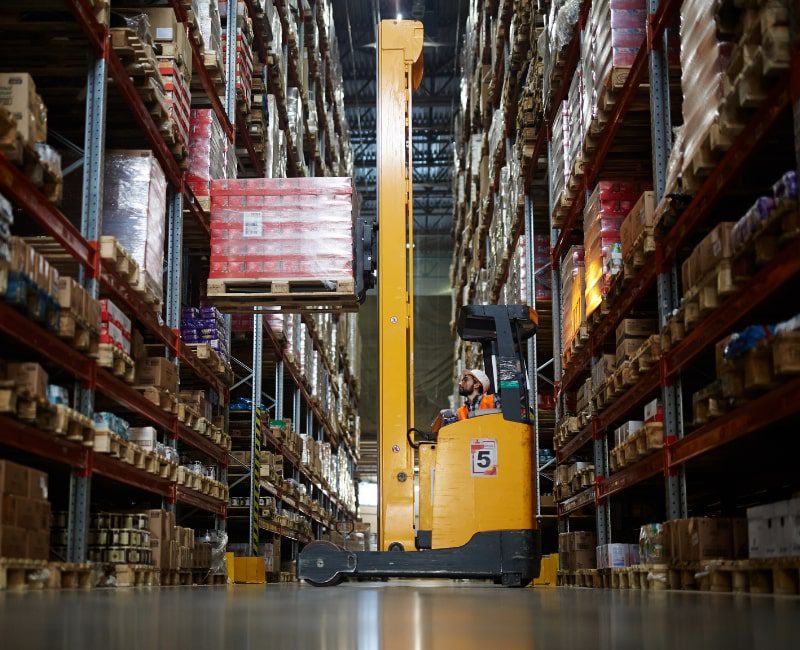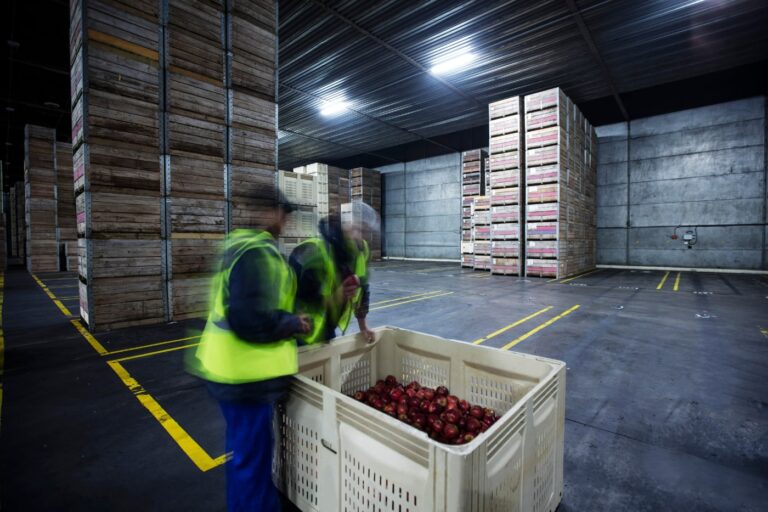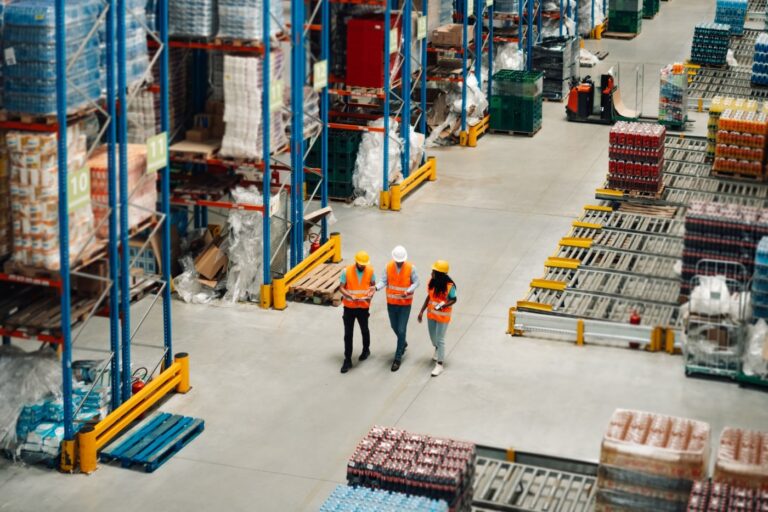The smooth flow of goods in today’s interconnected world relies on a complex network of facilities known as logistics centers. These critical hubs orchestrate the efficient storage, movement, and distribution of countless products, playing a vital role in global supply chains.
Whether you’re a logistics professional seeking to deepen your knowledge, a business owner optimizing your supply chain, or simply curious about the invisible forces behind everyday deliveries, this guide offers valuable insights and a comprehensive understanding of how logistics centers function.
Take a journey into the heart of logistics operations and uncover the intricate network that powers the flow of goods in our modern world.
Key Components of a Logistics Center
The components comprising a logistics center are what orchestrate the seamless movement of goods through the supply chain. This section delves into the essential physical and technological infrastructures that support the functionality of a logistics center.

Physical Infrastructure
The physical infrastructure of a logistics center forms the framework within which goods are stored, processed, and distributed. It encompasses various elements essential for the smooth functioning of operations.
Warehouse Space: Central to the logistics center’s operations is the provision of ample warehouse space. This space serves as the primary repository for incoming inventory, providing a designated area for the storage and organization of goods based on their nature, size, and demand patterns.
Loading Docks: Loading docks are interfaces between the logistics center and vehicles. These designated areas facilitate the seamless transfer of goods between trucks, trailers, and the warehouse facility, ensuring efficient loading and unloading processes.
Storage Facilities: Within the warehouse space, storage facilities are strategically configured to accommodate diverse types of goods. From rack systems and shelving units to specialized storage solutions such as cold storage or hazardous materials containment, these facilities are tailored to optimize storage density and accessibility while adhering to safety and regulatory standards.
Technological Infrastructure
Complementing the physical infrastructure, the technological backbone of a logistics center comprises sophisticated systems and tools designed to enhance operational efficiency, accuracy, and visibility throughout the supply chain.
Inventory Management Systems: At the heart of logistics center operations lie advanced inventory management systems. These software platforms provide real-time visibility into inventory levels, locations, and movement, enabling precise inventory tracking, forecasting, and replenishment to meet fluctuating demand patterns effectively.
Automated Sorting Systems: Automated sorting systems leverage cutting-edge technologies such as conveyor belts, robotic arms, and barcode scanners to streamline the sorting and routing of goods within the logistics center. By automating repetitive tasks and minimizing manual handling, these systems accelerate order fulfillment processes while minimizing errors and operational costs.
Tracking and Tracing Technologies: To ensure end-to-end visibility and accountability, logistics centers deploy tracking and tracing technologies. Through the integration of RFID tags, GPS tracking devices, and cloud-based software solutions, these technologies enable real-time monitoring of shipments, providing stakeholders with actionable insights into the status and location of goods at every stage of the supply chain.
Operations of a Logistics Center
The operational function of a logistics center is critical for the efficient movement and distribution of goods. This section delves into the multifaceted tasks undertaken by logistics centers, underscoring their significance in optimizing inventory flow, meeting customer demands, and enhancing operational efficiency.

Receiving and Unloading
The initial stages of the logistics process encompass the receipt and unloading of incoming shipments, a juncture where goods transition into the logistics center’s domain.
Inspection and Quality Control: Upon arrival, shipments undergo meticulous inspection and quality control procedures to ensure compliance with predetermined standards and specifications. This process involves assessing the condition, quantity, and integrity of goods, mitigating the risk of receiving damaged or defective items.
Inventory Check-in: Following inspection, goods are systematically checked into the logistics center’s inventory management system. Each item is assigned a unique identifier and allocated to its designated storage location, facilitating seamless tracking and retrieval throughout its lifecycle within the facility.
Storage and Inventory Management
Central to the operations of a logistics center is the effective management of stored inventory, optimizing space utilization and accessibility while minimizing the risk of stockouts or overstock situations.
Organization and Shelving Systems: Logistics centers employ a variety of organizational strategies and shelving systems to maximize storage capacity and streamline inventory retrieval. From pallet racking and mezzanine shelving to bin locations and automated storage solutions, these systems are tailored to accommodate diverse product types and demand profiles.
FIFO and LIFO Inventory Practices: To maintain inventory integrity and minimize obsolescence, logistics centers adhere to established inventory management principles such as First-In-First-Out (FIFO) or Last-In-First-Out (LIFO). These practices dictate the order in which goods are picked and replenished, ensuring optimal stock rotation and freshness while mitigating the risk of product spoilage or expiration.
Order Fulfillment
Efficient order fulfillment lies at the heart of logistics center operations, encompassing the processes involved in picking, packing, and preparing shipments for dispatch to end customers.
Picking and Packing Processes: Utilizing advanced picking technologies and order fulfillment strategies, logistics centers optimize the retrieval and consolidation of items to fulfill customer orders accurately and expediently. Whether through manual picking, batch picking, or zone picking methodologies, these processes are designed to minimize picking errors and maximize productivity.
Shipping Preparation: Once orders are picked and packed, logistics centers proceed with the final stages of shipping preparation, which may include labeling, packaging, and documentation for regulatory compliance and shipment tracking purposes. Through seamless integration with transportation management systems, logistics centers coordinate the timely dispatch of shipments to designated delivery destinations.
Transportation Management
The culmination of logistics center operations involves the orchestration of transportation logistics, ensuring the efficient movement of goods from the facility to their final destinations.
Coordination with Carriers: Logistics centers liaise with transportation carriers to schedule pickups, allocate freight capacity, and negotiate favorable shipping rates. By forging strategic partnerships with carriers, logistics centers optimize transportation routes and modalities to minimize transit times and mitigate transportation costs.
Route Optimization: Leveraging advanced route optimization algorithms and real-time traffic data, logistics centers optimize delivery routes to maximize efficiency and minimize fuel consumption. Through dynamic route planning and dispatching, logistics centers mitigate the impact of traffic congestion and unforeseen disruptions, ensuring timely and cost-effective delivery of goods to customers.
Importance of Efficiency in Operations
Efficiency in operations is a strategic imperative for logistics centers. By optimizing processes, minimizing waste, and maximizing resource utilization, various benefits can be achieved throughout the supply chain. Logistics centers unlock new opportunities for growth by prioritizing cost reduction, faster turnaround times, and improved customer satisfaction.

Cost Reduction
Cost reduction remains a paramount concern, with operational inefficiencies often translating into unnecessary expenditures. By prioritizing efficiency in logistics center operations, clients reap substantial cost savings through various avenues:
Optimized Resource Utilization: Efficient operations minimize waste and redundancies, ensuring that resources such as labor, warehouse space, and transportation assets are utilized effectively.
Streamlined Processes: Eliminating bottlenecks and inefficiencies in receiving, storage, and fulfillment processes reduces operational overheads and enhances productivity, ultimately driving down operational costs.
Improved Inventory Management: By implementing effective inventory management practices, such as real-time visibility and demand forecasting, logistics centers can minimize carrying costs, obsolescence, and stockouts, optimizing inventory investment and reducing carrying costs.
Faster Turnaround Times
In today’s fast-paced business environment, speed and agility are imperative for maintaining competitiveness and meeting customer expectations. Efficient operations enable 3PL clients to achieve faster turnaround times, facilitating:
Quicker Order Fulfillment: Streamlined picking, packing, and shipping processes expedite order fulfillment, allowing clients to meet tight delivery deadlines and capitalize on time-sensitive opportunities.
Reduced Lead Times: By optimizing transportation routes, inventory positioning, and order processing workflows, clients can significantly reduce lead times, enhancing responsiveness and flexibility in meeting customer demand fluctuations.
Enhanced Supply Chain Agility: Efficient operations empower clients to respond swiftly to market dynamics, adapt to changing customer preferences, and capitalize on emerging opportunities, thereby gaining a competitive edge in the marketplace.
Improved Customer Satisfaction
At the heart of every successful logistics center lies the commitment to delivering superior customer experiences. Efficiency plays a pivotal role in driving customer satisfaction by:
Ensuring Order Accuracy: Efficient picking, packing, and shipping processes minimize errors and discrepancies, ensuring that orders are fulfilled accurately and aligned with customer expectations. According to Datex Corporation, retailers that outsource distribution to 3PLs have reported a 30% improvement in order accuracy.
Meeting Delivery Expectations: Faster turnaround times and reliable transportation logistics enable clients to meet or exceed delivery expectations, enhancing customer satisfaction and loyalty.
Enhancing Communication and Transparency: Efficient operations facilitate real-time visibility into order status, inventory levels, and shipment tracking, empowering clients to provide proactive communication and timely updates to customers, fostering trust and transparency.
Future Trends and Innovations in Logistics Center Operations
As the logistics industry evolves to meet the evolving demands of a globalized marketplace, staying ahead of emerging trends and innovations is paramount for logistics centers. This section delves into three key areas poised to shape the future of logistics operations, presenting opportunities for optimization, efficiency, and sustainability.

Robotics and Automation
Robust advancements in robotics and automation technologies are revolutionizing traditional logistics center operations, heralding a new era of efficiency, accuracy, and scalability. Key trends in this domain include:
Autonomous Mobile Robots (AMRs): These intelligent robots navigate warehouse environments autonomously, performing tasks such as goods-to-person picking, inventory replenishment, and floor cleaning, thereby enhancing operational agility and productivity.
Automated Guided Vehicles (AGVs): AGVs leverage navigation systems and sensors to transport goods within logistics centers, streamlining material handling processes and minimizing reliance on manual labor.
Warehouse Automation Systems: From robotic picking systems and automated conveyor belts to robotic arms for palletizing, warehouse automation solutions are revolutionizing order fulfillment processes, enabling faster throughput and greater accuracy.
Predictive Analytics for Demand Forecasting
Predictive analytics is emerging as a powerful tool for enhancing supply chain resilience and responsiveness. By leveraging historical data, machine learning algorithms, and advanced statistical models, logistics centers can anticipate demand patterns with unprecedented accuracy, enabling proactive decision-making and resource allocation. Key trends in this domain include:
Demand Sensing: Real-time data analytics enable logistics centers to capture and analyze demand signals across multiple touchpoints, providing insights into shifting consumer preferences and market trends.
Predictive Maintenance: By harnessing predictive analytics to monitor equipment health and performance, logistics centers can proactively identify and address maintenance issues before they escalate, minimizing downtime and optimizing asset utilization.
Dynamic Pricing Optimization: Predictive analytics empower logistics centers to optimize pricing strategies based on demand forecasts, market conditions, and competitive dynamics, maximizing revenue and profitability.
Sustainable Practices in Logistics Operations
With sustainability being a pressing global issue, logistics centers are increasingly embracing eco-friendly practices and technologies to minimize environmental impact and enhance operational sustainability. Key trends in this domain include:
Green Logistics Solutions: Logistics centers are adopting renewable energy sources, such as solar panels and wind turbines, to power warehouse operations and reduce reliance on fossil fuels, thereby lowering carbon emissions and energy costs.
Efficient Packaging Solutions: Sustainable packaging materials, such as biodegradable plastics and recyclable materials, are gaining traction within logistics operations, minimizing waste and enhancing recyclability throughout the supply chain.
Last-Mile Optimization: By leveraging route optimization algorithms and alternative delivery methods, such as electric vehicles, logistics centers can reduce fuel consumption and congestion in urban areas, while also improving delivery speed and reliability.
Shaping Tomorrow’s Supply Chains
As we conclude this exploration into the intricate world of logistics centers, it’s clear that these dynamic hubs are much more than simply warehouses; they are the beating heart of modern commerce. From their physical infrastructure and technological advancements to their meticulously honed operational processes, logistics centers play a pivotal role in ensuring the efficient flow of goods and driving economic growth.
However, the journey doesn’t end here. As technology continues to evolve and customer expectations shift, the future of logistics center operations promises to be even more dynamic and innovative. The integration of robotics, artificial intelligence, and predictive analytics will further streamline processes, enhance agility, and optimize resource utilization. Sustainability initiatives will take center stage, with eco-friendly solutions minimizing environmental impact and promoting responsible practices.
The key takeaway remains: logistics centers are not just about storing and moving goods; they are about delivering value. By staying at the forefront of innovation and embracing operational excellence, these facilities can ensure the smooth functioning of supply chains, enhance customer satisfaction, and ultimately contribute to a more efficient and sustainable global economy. Are you ready to elevate your business operations? Explore our comprehensive network of warehouse locations to discover how Hanzo Logistics can optimize your supply chain.



